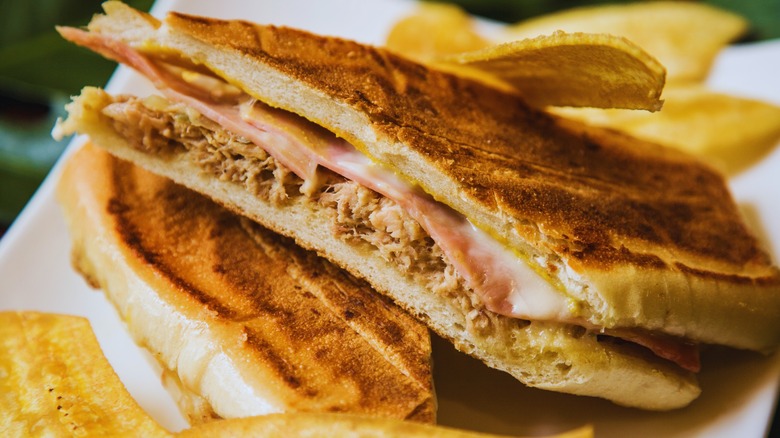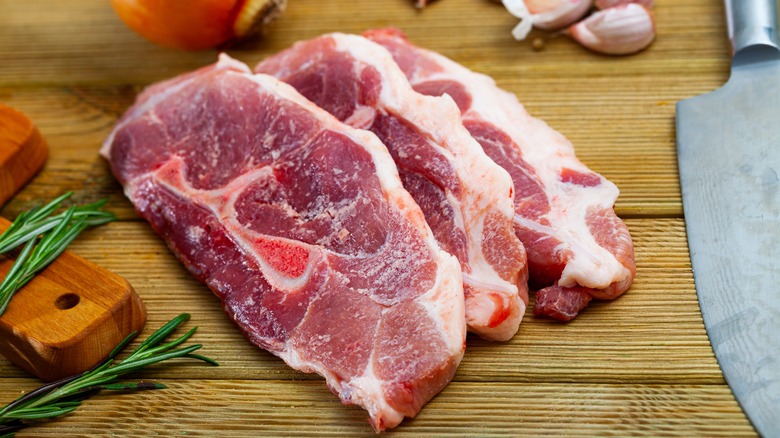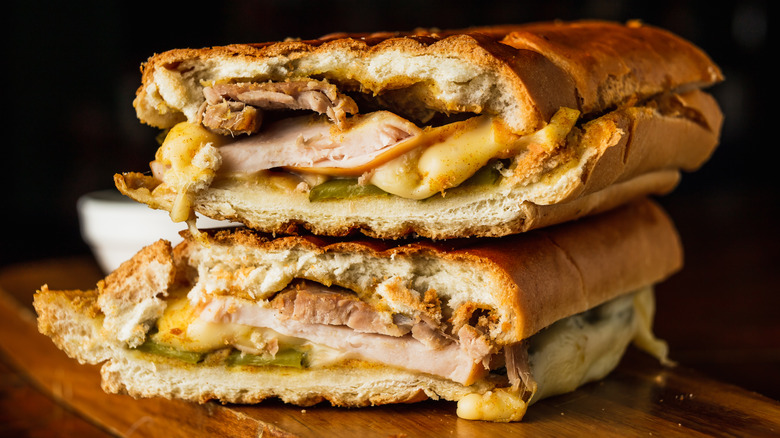The Best Cut Of Pork To Use For A Traditional Cuban Sandwich
Pork is a critical ingredient in a Cuban sandwich — and the best cut of meat to use is thinly sliced, slow-roasted pork shoulder. Not only is this cut affordable and flavorful, but the methods for cooking pork shoulder are typically hands-off, requiring only some prep work and an occasional check to make sure the protein is cooking properly.
Pork shoulder is the standout of any Cuban sandwich, thanks to its robust flavor compared to traditional deli meat. Combined with the sharp tastes of mustard and pickle, and the saltiness of ham and Swiss cheese, the rich flavors brought out by applying a low-and-slow cooking method to a pork shoulder elevate a Cuban sandwich beyond being a leveled-up grilled cheese.
Like any recipe, "how to make a Cuban sandwich" becomes a broader question as its popularity grows. Some people may prefer to use pimento cheese rather than Swiss, and some may opt for salami instead of ham. But constant as the North Star, roasted pork can and should be found in any authentic Cuban sandwich.
Why is roasted pork shoulder best for a Cuban sandwich?
While the exact history of the Cuban sandwich is unclear, it first arrived in America via Cuban workers immigrating to Florida. Pork shoulder has a long history in North America as a tough, cheap cut of meat with serious potential for those with patience. Popular among the working classes of the 19th and 20th centuries, pork shoulder was an affordable way to keep a heavy dose of tasty protein in a busy person's diet.
However, pork shoulder needs time to reach its full potential. The fat and connective tissue in pork shoulder, not to mention the untapped flavor in that thick bone, require plenty of time to release their flavor into the meat. But for someone willing to take the time, slow-cooked pork shoulder delivers an almost unparalleled ratio of flavor to value while also yielding pounds of succulent meat.
For Cuban sandwiches, a pork shoulder needs time to rest to keep the juices from spilling out when cut. Once the fully assembled sandwich starts cooking in a plancha — a cast-iron flat-top grill — the sliced pork shoulder warms through and returns to its naturally juicy state. Traditionally made with just a thin spread of mustard, the juices in a pork shoulder combine with the brine from the pickles to create a sandwich that needs no heavy saucing or additional moisture.
Tweak your Cuban sandwich to your preferences
One of the most hotly debated elements of a Cuban sandwich is whether you should pre-cook the sliced pork shoulder or not. Some folks opt to fry the slices on both sides in a bit of butter or oil, browning the meat to provide a more robust flavor. Others are purists who want to retain as much of the pork shoulder's juices as possible, believing that the heat from the plancha is sufficient to warm the pork through.
Marinades and seasonings for a Cuban sandwich's pork shoulder should always accommodate your personal tastes. If you want more tang, add a higher ratio of citrus. If you want the pork to really shine, consider focusing your spices on bay leaf and oregano. Some enterprising pitmasters even smoke a pork shoulder to create a barbecue Cuban sandwich, though you are unlikely to see this in a Cuban restaurant or home.
But for a truly traditional Cuban sandwich, you'll need to marinate the pork in mojo, a Cuban marinade consisting of garlic, herbs, onions, and orange juice. Simple to make and impossible to resist, sour orange mojo is best made at home. Whether you're marinating a pork shoulder overnight for a long roast or simmering it in a crockpot to create tangy pulled pork, mojo provides an extra layer of flavor to your roasted protein that pairs excellently with every last Cuban sandwich ingredient.



